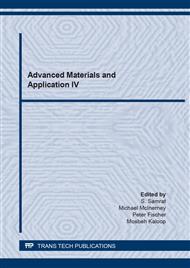p.47
p.53
p.61
p.69
p.79
p.89
p.101
p.111
p.117
Gravimetric and Data Analysis of the Protection Performance of Plant Extracts on Plain Carbon Steel in Dilute H2SO4 Solution
Abstract:
Analysis of the protection performance of kolanut leaves (KL), kolanut fruits (KF), tobacco leaves (TL) and bitter leaves (BL) extracts at 30%, 60% and 80% concentration on plain carbon steel in 0.5 M H2SO4 solution was done by gravimetric measurement and statistical evaluation. Data output showed KF and TL extracts performed effectively at all concentrations studied with protection performance output generally above 80%. KL and BL extracts performed poorly at the lowest concentration while at higher concentrations optimal protection performance outputs are 74.41% and 83.53%. The protection performance outputs of KL, KF and TL extracts varied significantly with observation time due to thermodynamic instability and unstable inhibition behavior. BF extract exhibited stable inhibition behavior due to general stability of its protection performance outputs with respect to observation time. BF and KL exhibited the highest and lowest standard deviation due to the degree of variation of their protection performance outputs from mean value. Data showed 9.5%, 76.2%, 76.2% and 71.4% of the protection performance outputs of KL, KF, TL and BL extracts are above 80% inhibition performance at margin of error of 12.6%, 18.2%, 18.2% and 19.3%. Data from analysis of variance shows that observation time exerted more influence than extract concentration on the protection performance outputs of KL, KF and TL extracts with statistical relevance values of 91.24%, 91.93% and 93.61%. BL extract concentration exhibited significant influence on the protection performance outputs of BL compared to observation time with statistical relevance values of 81.43%.
Info:
Periodical:
Pages:
79-87
Citation:
Online since:
August 2021
Keywords:
Price:
Сopyright:
© 2021 Trans Tech Publications Ltd. All Rights Reserved
Share:
Citation:


